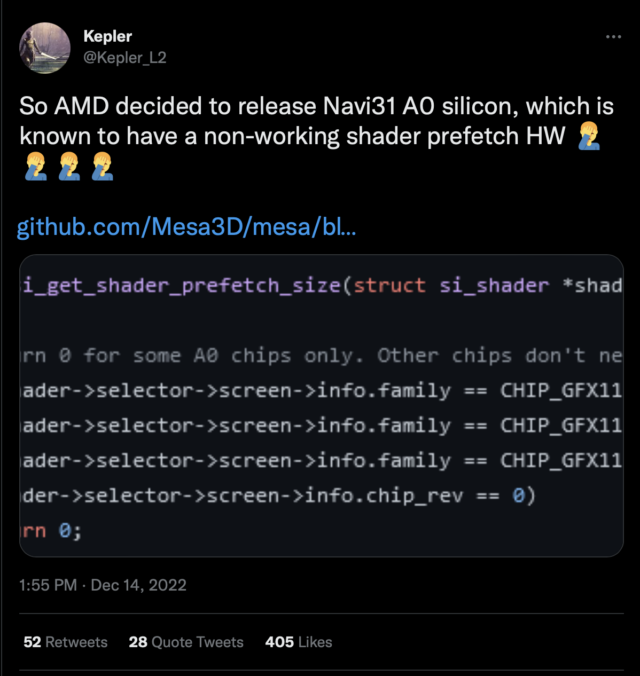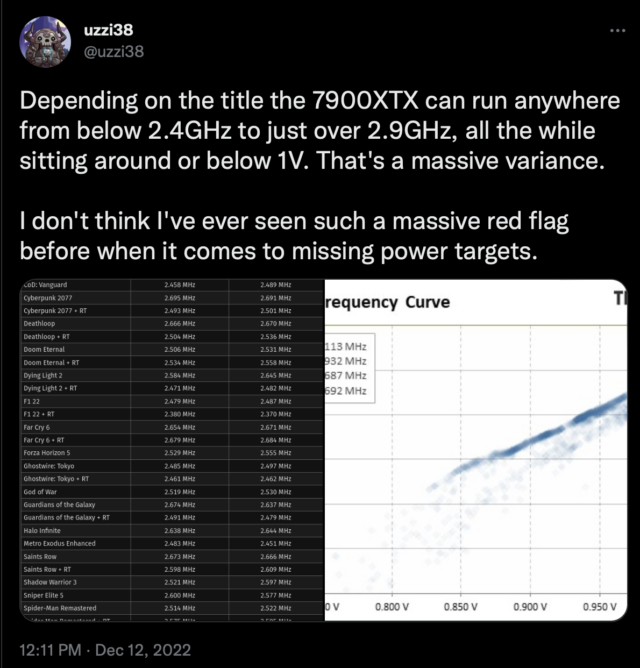
Some AMD Radeon RX 7900 XTX GPUs Are Showing Wildly Fluctuating Clock Speeds, Possible Early Silicon
AMD’s long-awaited RDNA3 GPUs launched on Dec. 13, and although they didn’t score a knockout victory over their rivals in early tests, they’re clearly worthy competitors. Their main flaw, reviewers noted, was lackluster ray tracing performance, to the surprise of exactly nobody. But now that the dust has settled and cards are in gamers’ hands, reports have surfaced online showing a variety of bizarre issues. The most troubling accuses AMD of shipping the Radeon RX 790 XTX with very early silicon with disabled shader prefetch hardware.
The above is still unverified at the time of this writing, but here’s what we know.

Another user named Davidbepo posted a similar situation with Navi31, where an XTX card showed two different steppings. In , the card is shown in GPU-Z as being C8 stepping, while also using A0 silicon. That is strange, as A0 would be the first revision of the hardware; it should have advanced for the final product. It’s possible AMD shipped early silicon with a broken shader prefetch in some cards. It’s seemingly also not working in Nav33, the company’s midrange GPUs. This isn’t verified yet, either, but if it’s true, AMD would need to ship new silicon to rectify it.
Other reports show wildly fluctuating clock speeds. Twitter user reported the XTX’s clocks can fluctuate between 2.4GHz and 2.9GHz with no settings changed, which is quite a spread. They linked to efficiency benchmarks, which show an even wider level of fluctuating clock speeds. In those tests, the XTX displayed a 1GHz range of clock speeds, from 1,934MHz to 2,994MHz. Even worse, their card ran at 1.6GHz in Furmark. We’re all used to GPU clocks varying according to load and temps, but that is an unprecedented range in production.

A tech YouTuber in the Netherlands named found similar bizarre behavior on the Asus version of the XTX. She reports she ran Call of Duty at 350fps and 2.9GHz, which ran it faster than an RTX 4090. However, an hour later it dropped to 300fps and 2.4GHz, with no changes to any settings. Her GPU also produced some , but that’s why we have headphones we suppose. AMD graphics chief to her that the company would be in touch so they could try to figure it out, so it seems like something weird is happening. And also noted its XTX was consuming over 100W of power sitting at the desktop with a multi-monitor setup, which is just weird.
This is all a mystery that we hope AMD can add some clarity to. The A0 stepping could be fixed with a hardware refresh, but that’s little consolation to current card owners. It’s been reported that the shader prefetch being disabled only causes a drop in performance of five percent with RDNA2. Given how different RDNA3 is in terms of architecture, it’s unknown what effect that has here. For now, we will have to wait to see if AMD chimes in.
Now Read: